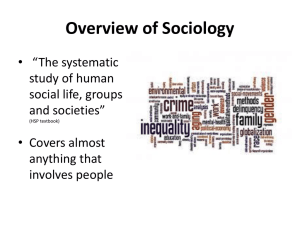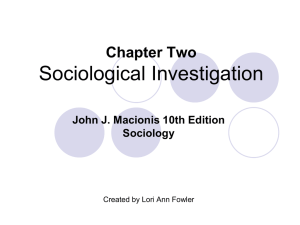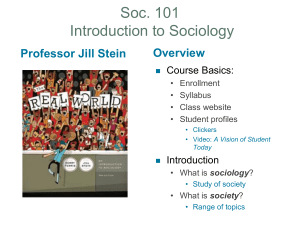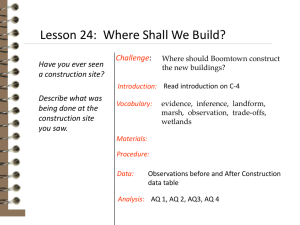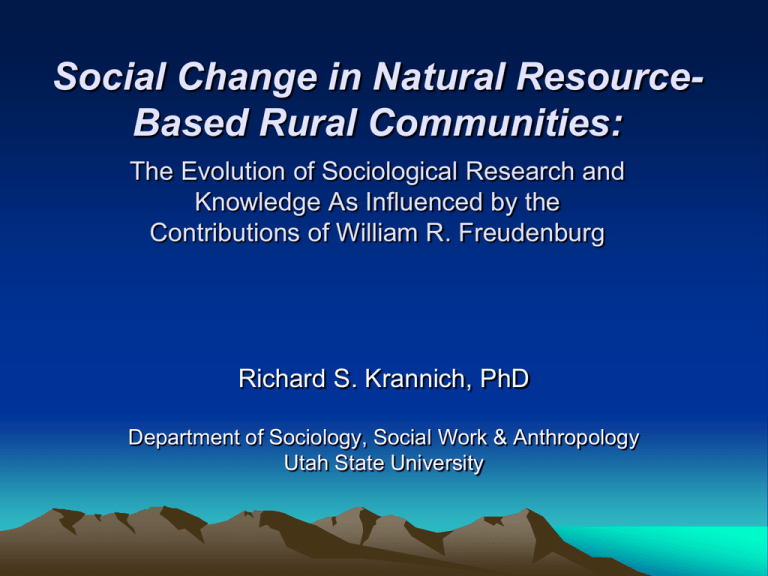
Social Change in Natural ResourceBased Rural Communities:
The Evolution of Sociological Research and
Knowledge As Influenced by the
Contributions of William R. Freudenburg
Richard S. Krannich, PhD
Department of Sociology, Social Work & Anthropology
Utah State University
Some Historical Background
• The 1973 Arab oil embargo, and resulting shortfalls in U.S. energy
supplies
• “Project Independence” launched by Nixon to stimulate domestic
energy exploration and production
• Combined with resource price increases, this contributed to a surge
of resource development activity, especially in the northern Great
Plains and Rocky Mountain regions
• Location of most developments in spatially remote, sparsely
populated areas with limited local labor availability. Led to massive
in-migration of workers and dependents, and “boomtown” growth
conditions in many settings
• Overwhelming of local infrastructure and service capacities
observed, and early signs of adverse effects on human quality of life
and “social disruption” consequences
Enter Freudenburg:
Major Contributions Addressing the Social Consequences
of Resource-Based Growth and Development
Five Key Areas of Contribution:
•Raising consciousness and addressing problems of “inattention”
•Providing methodological guidance and leadership
•Promoting analytic rigor and depth
•Providing conceptual and theoretical guidance
•Laying foundations for future research
Raising Consciousness and Addressing
Problems of “Inattention”
•
1976 ASA paper, “The social impact of energy development on rural
communities; a review of literatures and predictions.”
•
1978 AAAS paper, “Toward ending the inattention: A report on the social
consequences of energy boomtown developments.”
•
Key shortfalls and limitations identified, including:
– Limited extent and accessibility of what was at the time a largely “fugitive”
literature
– Limited evidence of extrapolation from analogous impact experiences
– Tendency for “socioeconomic” analyses to exclude the social and focus on fiscal
and employment issues
– “Social” analyses either absent or focused solely on impacts of population growth
on service and infrastructure demand
– Reports of boomtown impacts often impressionistic, without clear evidence of
data adequacy or documentation
•
A call for assessments addressing “genuinely social” consequences of
development such as community cohesion, social integration, and
subjective quality-of-life dimensions
•
Emphasis on the need to avoid fallacies of misplaced aggregation, by
attending to the importance of “distributive impacts” that are differentially
distributed across social groups and sub-populations
•
In general, a call for attention to the importance of carefully structured and
more self-consciously sociological investigations of boomtown growth and
its impacts, AND for serious attention to such impacts on the part of policy
makers
Providing Methodological
Guidance and Leadership
•
Early sociological debates over whether “social disruption” was really
occurring in boomtown settings, or whether such assertions were at least in
part a product of innuendo, undocumented assertions, limited data, and
poor research designs (Thompson 1979; Wilkinson et al. 1982)
•
Bill’s early works summarizing the state of SIA and boomtown research
highlighted multiple strategies for improvement:
– More careful articulation of theoretically-guided research questions
– Implementation of comparative, multi-community research designs
– Implementation of longitudinal research to effectively track social change
patterns
– Analytic strategies to sift out differential impact distributions
Leading by example: Bill’s boomtown
research in western Colorado:
•Eschewed single-community case study approach for a comparative design
involving one major boomtown case and three comparison or “control”
communities
•An ambitious mixed-methods research strategy:
–
–
–
–
–
Extended and in-depth ethnographic research (initially 16 months in the field)
Random probability sample surveys of adult residents in four study communities
Random probability sample surveys of adolescents in four study communities
Collection and analysis of varied existing data (crime reports, mental health center case
records, etc.)
Capacity for longitudinal assessment through extension of ethnographic inquiry (at least 10
years) and analyses of secondary data covering extended time frames
•Overall, a methodological benchmark against which other boomtown analyses
should be compared
Promoting Analytic Rigor and Depth
“Women and men in an energy boomtown: Adjustment, alienation
and adaptation” (Rural Sociology, 1981)
•Focus on survey-based measures of subjective quality of life, social integration, and
personal alienation
•Complex series of analyses disaggregating response patterns by sex, across boomtown
and non-boom settings, and by newcomer/old-timer status
•Generated fine-grained and nuanced insights regarding differential response and
distributive nature of impacts… “old-timer” men in the boomtown exhibited higher levels
of alienation; “newcomer housewives” exhibited lower social integration than women
engaged in the workforce
“Boomtown’s youth: The differential impacts of rapid community
growth on adolescents and adults” (American Sociological
Review, 1984)
•Multiple measures focusing on attitudes about development and local community
conditions, life satisfaction, and anomie/alienation
•Comparisons of response patterns across both community contexts (boomtown and
non-boom settings) and between adults and adolescents
•Contrary to conventional wisdom, no significant differences among adults across the
boom and non-boom community settings
•Also contrary to assumptions, boomtown adolescents seemed MOST adversely
affected… more negative evaluations of community, more negative attitudes about
growth, lower life satisfaction, higher alienation
–
Ethnographic data provide a richly-detailed interpretation focusing on barriers to “buffering”
options among adolescents, and age-specific vulnerabilities associated with peer interactions
and still-emergent self-identities
Conceptual and Theoretical Guidance
“The density of acquaintanceship: An overlooked variable in
community research” (American Journal of Sociology, 1986)
•Builds on classical theoretical traditions in sociology… Tonnies, Weber and Simmel in
particular, and theoretical foundations in urban sociology and social network research
•Highlights the importance of distinguishing between individual-level “isolation and
estrangement” and community-level structural conditions reflecting the proportion of
residents acquainted with one another
•Presents propositions regarding potential for reduced density of acquaintanceship to
alter informal social process that contribute to overall community functioning: deviance
control, socialization of youth, and “caring” processes that support those needing
accommodation or assistance
–
Ethnographic and survey data analyses from western Colorado show “virtually no evidence of the individuallevel atomization of Tonnies’s Gesellshaft”
–
BUT, consistent evidence of diminished effectiveness of informal deviance control and socialization
processes, and selective reductions in effectiveness of informal caring processes.
“Addictive economies: Extractive industries and vulnerable
localities in a changing world economy” (Rural Sociology, 1992)
•Shift from focus on energy boomtowns to broader conditions and concerns of resource
dependency
•Complex mechanisms that contribute to vulnerability involving adverse social and
economic consequences:
–
–
–
–
The “cost-price squeeze” and associated instability in resource-based industries
Random and typically spatially remote locations of major resource deposits
Increasingly large scale of modern resource extraction and processing operations
Limited potential for economic diversification in many extractive settings
•Also, multiple “ambiguities” acting as barriers to pursuit of development strategies that
could reduce vulnerability and instability:
–
–
–
–
Volatility of resource prices and related cyclical shifts in economic activity and opportunity
Mixed blessings of ‘good jobs’ that produce high wages but create disincentives for
development of alternative employment skills or entrepreneurship
Uncertainties as to whether and when “resource exhaustion” may occur
“Over-adaptation” process involving high levels of specialization and reliance on single
resource-based development paths
“Opportunity-threat, development, and adaptation: Toward a
comprehensive framework for social impact assessment”
(Gramling and Freudenburg, Rural Sociology, 1992)
•Highlights a conceptual framework emphasizing differing patterns of social
change that accompany distinct phases of the development cycle (pre-project
planning phase; project implementation or development phase; post-project
phase)
•Key contribution is an elaboration of the concept of “opportunity-threat”
impacts:
– Emergence of different and often competing social constructions of the positive
or adverse implications of a project across varying social groups with differing
interests and agendas
– Potential for these differing perspectives to contribute to an array of social
impacts, particularly in situations involving controversial projects with high
potential for environmental damage, risks to human health and safety, or
inconsistencies with other development paths and prospects
Laying Foundations for Future Research
In short:
“… it should be clear that the cumulative impact of his work in this arena has
been nothing short of remarkable. Over the course of his career he has played
and continues to play a lead role in bringing the need for careful examination of
such issues to the attention of both social scientists and policy makers. In
addition, his contributions with respect to methodological direction, theoretical
explanation, and empirical observation provide a solid foundation that has
provided guidance to nearly all subsequent work addressing related issues.
Indeed, one would be very hard-pressed to locate any work addressing issues
pertaining to the social impacts of rapid growth and resource development or
dealing more generally with the social implications of resource dependency
published over the past 30 years that has not cited at least a portion of
Freudenburg’s work.”
Several Promising Avenues for Building on These Foundations:
•Examining the implications of changes in resource development processes
and technologies regarding “social disruption” potential:
–
–
Implications of differing types of energy and resource developments… wind and solar energy
installations, etc.
Consequences of altered work force requirements accompanying technological change in
exploration, extraction and development processes… e.g., multi-well drilling pads, etc.
•Exploring the multiple ways in which “context” matters:
–
–
–
Variations associated with temporal/ and historical context
Regional and local variations in social, economic and political circumstances
Locational isolation or proximity and the influence of spatial forces
•Further exploration of longitudinal patterns of change and adaptation:
–
Data collection and analyses that extend across multiple “cycles” of growth and decline
•Examining cross-cultural and cross-national variations
–
Examining the social impacts of large-scale resource developments and of “social disruption”
outcomes in cross-national comparative studies
THANKS
BILL!!!


